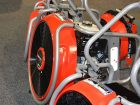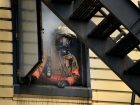
Features
Structural
Training
Trainer’s Corner June 2017: A firefighters’ ovation for ventilation
Training in the fire services is not for the faint of heart. The time, energy and plain old hard work can be overwhelming at times. However, every now and then, a young firefighter looks at you and says, “I get it.”
May 24, 2017
By Ed Brouwer
I am pleased to say that has been happening to me more often lately. Maybe after nearly 30 years I’m finally starting to get a handle on dealing with students? As a training officer, if you can’t engage your members, you will miss the mark.
At a recent practice, something surprising happened. The subject was basic ventilation and during an airflow demonstration the members spontaneously broke into applause. That’s right, they clapped! To this point, that had happened only one other time during a training session, but under very different circumstances.
That was in 2004, when we introduced Saving Our Own training at the Oliver volunteer firefighters spring training. Our first group included members of the Clearwater Fire Department, who had just lost one of their own, 23-year-old Chad Schapansky, that March. It was in Schapansky’s honour that we demonstrated a through-the-floor rescue. As we wrapped up, the applause started, followed by a few tears and more applause. Overwhelming is an understatement. But that applause was in respect to a line-of-duty death.
I never expected I would hear applause for an airflow demonstration, perhaps one of the simplest demos I have ever done.
In a nutshell, ventilation is the planned, co-ordinated and systemic removal of pressure, heat, gases and smoke. This can occur as a natural result during a fire or it can be produced by mechanical means: positive pressure ventilation (PPV fans); negative pressure (ejectors/extractors); and, when other types of ventilation are unavailable, hydraulic ventilation is an option.
Ventilation is simply the movement of air from high pressure to lower pressure. Three major reasons to perform ventilation are life safety, incident stabilization and property conservation.
There are two types of mechanical ventilation: horizontal and vertical. Both can be extremely dangerous if not preformed properly. Firefighters must have a fundamental understanding of fire behaviour, fire streams and ground ladders before they attempt to open a roof.
Most important, before you ventilate, you had better know where the seat of the fire is.
Greenwood Fire Department has decided not to do mechanical vertical ventilation. In consideration of our aging department members, the low number of structure fires per year and the structure types in our community, we no longer cut holes in the roof. In some cases, we may ventilate through gable ends.
We have learned that once we ventilate, conditions change rapidly, and not always in our favour.
For clear instruction on vertical ventilation go to www.firefightingincanada.com, click training/structural, and scroll to Mark van der Feyst’s Back To Basics series from November 2013, and February and March 2014. There are also myriad demonstrations on YouTube. For that reason, I will forego my lesson plan and take you right to my demo.
All you need to demonstrate air flow is some duct tape and flagging tape. Before the practice, tear off a three-foot piece of duct tape. Cut 20 flagging tape strips into 10 three-foot and 10 four-foot lengths. Then place one end of the flagging tape on the duct tape, pressing down so it sticks. Alternate between the three- and four-foot lengths with approximately an inch between. When you have completed that step, tear another three-foot piece of duct tape and place it sticky-side down on the first piece of duct tape.
I made up another three-foot prop with shorter flagging tape strips (one-foot and two-foot lengths).
Using your fire hall as the building to be ventilated, set up your PPV fan at one of the main doors. At this point in the demonstration, all other doors and windows should be closed. You can have a number of members start and run the PPV fan – it is always good practice.
Meanwhile, find another door inside the building, preferably far away from the first door. Tape the flagging strip to the top of the door. At our hall, we have an upper floor so I placed the second strip on an interior door to a room with a window that I could open. In our case, the window had a screen, which turned out to be a
huge bonus.
Now, returning to your crew, set the PPV fan several feet from the entrance door (inlet), allowing a cone of air to seal the opening. This prevents the air from recirculating. It is imperative you run the fan wide open, forcing air on the entry door and checking that you have a proper cone effect.
Remember, on the fire ground you would not open the inlet opening until you were ready with a co-ordinated opening of the “outlet.” The careful choosing and controlling of the outlet allows the smoke, heat and combustible products to follow the path of least resistance out of the structure.
With the fan situated and running full out, open the inlet door and have your members enter the hall. They should notice that although the air is being forced into the building, there is very little, if any, airflow. The building is being pressurized. Take your group to the main floor door where you hung the flagging tape. There should be minimal movement of the tape.
Now open the door. You should feel a sudden rush of air causing the flagging tape to flutter out of the doorway.
For mechanical ventilation to be effective, there must be an inlet and an outlet. Allow firefighters the opportunity to make observations, then close that door and go to your next set up. At the interior door, the flagging tape should be hanging without movement. Proceed to the window and open it up all the way. The streamers should begin waving in the direction of that window. Try closing the window halfway and notice the reduction in air movement. If your window has a screen, remove it and then ask the firefighters to observe what happens. The difference should be drastic.
At this point, the group seemed to collectively understand ventilation. Their reaction was to applaud. For this old trainer, it doesn’t get much better than to witness that type of engagement. Until next time, remember to train like lives depend on it, because they do.
Ed Brouwer is the chief instructor for Canwest Fire in Osoyoos, B.C., and deputy chief training officer for Greenwood Fire and Rescue. Ed has written Trainer’s Corner for 16 of his 28 years in the fire service. Contact Ed at aka-opa@hotmail.com
Print this page
Advertisement
- NFPA Impact June 2017: Sprinkler stipend program comes to Canada
- Re-framing risk: Using the public-ed matrix for a fresh first-line approach

